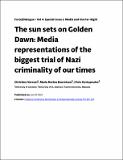Files in this item
The sun sets on Golden Dawn : media representations of the biggest trial of Nazi criminality of our times
Item metadata
| dc.contributor.author | Verousi, Christina | |
| dc.contributor.author | Boursinou, Maria Nerina | |
| dc.contributor.author | Kostopoulos, Chris | |
| dc.date.accessioned | 2022-02-15T11:30:07Z | |
| dc.date.available | 2022-02-15T11:30:07Z | |
| dc.date.issued | 2022-01-07 | |
| dc.identifier | 277506887 | |
| dc.identifier | de4b4e5c-161f-4711-9cfe-a103458d8c76 | |
| dc.identifier.citation | Verousi , C , Boursinou , M N & Kostopoulos , C 2022 , ' The sun sets on Golden Dawn : media representations of the biggest trial of Nazi criminality of our times ' , For(e)Dialogue , vol. 4 , no. 1 . https://doi.org/10.21428/e3990ae6.e6530756 | en |
| dc.identifier.other | Jisc: 2be154b151974f288f9a03633a91442f | |
| dc.identifier.uri | https://hdl.handle.net/10023/24877 | |
| dc.description.abstract | In September 2013, Pavlos Fyssas, a known musician and antifascist, was fatally stabbed by a Golden Dawn member. His death led to the arrest of the party’s leadership and the commencement of a trial which lasted almost 5.5 years and came to a close on October 7th 2020, adjudging the party’s leadership to be guilty of running a criminal organisation. The trial of Golden Dawn effectively brought about the end of the Neo-Nazi political party - once Greece’s third most popular party. Being branded as the biggest trial of Nazi criminality since the Nuremberg Trial, it also became a landmark in international modern history. Despite that, the trial received a disproportionate amount of coverage in proportion to its significance. The aforementioned come in contrast to mainstream medias’ earlier stance towards Golden Dawn, especially in the years from 2010 to 2013, when despite the party’s clearly aggressive ideology, rhetoric and activities, it received unprecedented media coverage that facilitated its legitimization. Existing research has shed light to the party’s relationship with and representation in the Greek mass media, however, no study has so far been preoccupied with media coverage of Golden Dawn’s trial. Examining a total of 257 articles published in three daily newspapers of political standpoints along the left-right spectrum of political opinion in Greece, this study investigates how the mainstream, traditional press managed the coverage of the trial’s culmination. Utilising frame analysis, the reconstructed sets of frames were critically analysed to uncover how the press framed the trial,the range of opinions represented through the publications, and its contribution to public debates around the Far-Right in Greece. Founded on an identified gap in the pre-existing research, this study offers a better understanding of the way in which mass media depict major events in society and in doing so it makes a timely contribution in the study of the Far-Right in Greece. | |
| dc.format.extent | 28 | |
| dc.format.extent | 664792 | |
| dc.language.iso | eng | |
| dc.relation.ispartof | For(e)Dialogue | en |
| dc.subject | GD trial | en |
| dc.subject | Far right | en |
| dc.subject | Fascism | en |
| dc.subject | Greece | en |
| dc.subject | Journalism | en |
| dc.subject | Mainstream press | en |
| dc.subject | Golden Dawn | en |
| dc.subject | JN Political institutions (Europe) | en |
| dc.subject | T-NDAS | en |
| dc.subject | SDG 16 - Peace, Justice and Strong Institutions | en |
| dc.subject | AC | en |
| dc.subject | MCC | en |
| dc.subject | NCAD | en |
| dc.subject.lcc | JN | en |
| dc.title | The sun sets on Golden Dawn : media representations of the biggest trial of Nazi criminality of our times | en |
| dc.type | Journal article | en |
| dc.contributor.institution | University of St Andrews. School of Geography & Sustainable Development | en |
| dc.identifier.doi | 10.21428/e3990ae6.e6530756 | |
| dc.description.status | Peer reviewed | en |
This item appears in the following Collection(s)
Items in the St Andrews Research Repository are protected by copyright, with all rights reserved, unless otherwise indicated.

